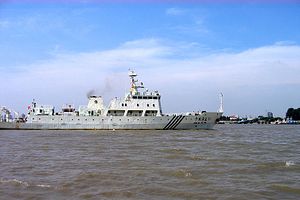While China’s recent assertiveness in the South China Sea might shock and surprise today’s observers, its behaviour has actually been remarkably consistent over recent decades.
China first exercised its power in the region in January 1974 when it ejected South Vietnam from the Crescent Islands. In March 1988, the Chinese Navy clashed with Vietnamese vessels, which resulted in Chinese occupation of seven islands in the Spratlys.
In 1995, China occupied Mischief Reef which fell in the exclusive economic zone (EEZ) of the Philippines. It then began building and reinforcing structures on neighbouring reefs. In April 2012 China’s clashes with the Philippines continued over Scarborough Shoal, which was eventually occupied by China. Chinese attention then moved to Second Thomas Shoal. In March 2014, Chinese coast guard vessels prevented Philippines cargo vessels from resupplying a contingent of marines stationed in a wrecked vessel there.
In April 2014 China moved the Haiyang Shiyou 981 oil rig into an area claimed by Vietnam, creating conflict with Vietnam that was only settled when the rig was removed ahead of schedule.
Since late 2014, China has engaged in extensive reclamation projects in eight locations across the Spratly Islands. Dredging work taking place on Fiery Cross Reef—which was previously under water—has been of notable concern. Chinese dredgers have been piling sand on the reef, raising it above the water level to allow for an airfield of 3,000 metres along its length. The reclaimed land could be transformed into an airfield that could support Chinese operations in the Spratlys. With air support for its coast guard, China would be able to threaten Vietnam and intimidate the Philippines.
With an increased presence in the Spratlys, China may also be in a position to impose its own resolution of maritime disputes upon the ASEAN claimants. That would entail a voluntary surrender on the part of the ASEAN claimants and their recognition of Chinese sovereignty over the South China Sea. Beijing would be in a position to offer the inducement of good relations and the benefits of trade and investment in infrastructure projects through the recently created Asian Infrastructure Investment Bank (AIIB).
Despite the pressure that China is placing on the ASEAN claimant it’s unlikely to achieve its goals. This is because its actions have increasingly involved external powers in the dispute. Both Vietnam and the Philippines have reached out to the US for support against China.
The Philippines and the US have a long history of military cooperation. In 1999 a Visiting Forces Agreement was concluded and in April 2014, when President Obama visited Manila, the Enhanced Defence Cooperation Agreement was finalised. The agreement allows the US Navy increased access to ports of the Philippines and provides for the rotation of US troops through their bases and airfields.
Vietnam has also been developing security ties with the US for the past decade in an effort to balance its relationship with Beijing. Constrained by its proximity to China, Vietnam can’t form too close a security relationship with the US, but the Vietnamese government hopes that a relationship with the US would have a restraining effect upon China.
While Malaysia and Indonesia have previously stood on the sidelines, Chinese activities in the area have stimulated their anxieties. Malaysia was jolted by Chinese naval patrols which reached James Shoal, the southernmost point of the Chinese claim falling within the Malaysia’s territorial claim. Publicly Malaysian leaders continue to bandwagon with China but defence officials are worried. Malaysia intends to construct a naval base in Bintulu in Sarawak—close to James Shoal—and the Malaysian defence ministry is now seeking US assistance and training to develop a marine corps based on the American model.
Indonesia previously regarded itself as a mediator of the dispute as a non-claimant. Recently, however, it’s become concerned about the sovereignty of the Natuna Islands. China’s claims clash with Indonesia’s ‘global maritime axis’ doctrine. Indonesia’s defence chief General Moeldoko has drawn attention to the dangers of instability in the South China Sea and has announced that additional Indonesian air units will be deployed to the Natuna Islands.
What does all of this have to do with Australia? Some would argue that Australia should avoid entanglement in East Asian affairs that could draw it into conflict between the US and China. The time when Australia could define its strategic interests so narrowly has passed; instability in the South China Sea would have consequences for Australia’s security environment.
Relentless Chinese pressure on the ASEAN claimants would draw in not only the US, but also Japan, which has its own concerns about Chinese intentions in the East China Sea, and specifically around the Senkaku/Diaoyu Islands. (Japan has also been seeking to strengthen the maritime capabilities of both Vietnam and the Philippines.) As external powers increasingly become involved, there’s the potential for ASEAN—which has been divided on the South China Sea dispute as non-claimant like Cambodia and Thailand prioritise relations with China—to fragment. ASEAN would continue with business as usual, but its lack of power would become more apparent.
A second result could be the polarisation of the region between China and its few allies, and the US–Japan relationship, to which disaffected states, fearful of Chinese rise and ambitions, would gravitate.
This situation could be averted if external powers voiced their concern about the South China Sea, and pressed China to cease its provocative actions and negotiate a code of conduct with ASEAN. In the past, China has responded to external pressure; a fear of external involvement has moderated its behaviour. China withdrew the oil rig from Vietnam’s EEZ in July 2014 after Vietnam launched an international shaming campaign to expose China’s actions. Indeed, Australia should contribute its voice to this cause in recognition of the fact that a united ASEAN is in its interests.
Leszek Buszynski is a visiting fellow at the Australian National University’s National Security College. This piece was first published in the Australia Strategic Policy Institute’s blog The Strategist here.
































